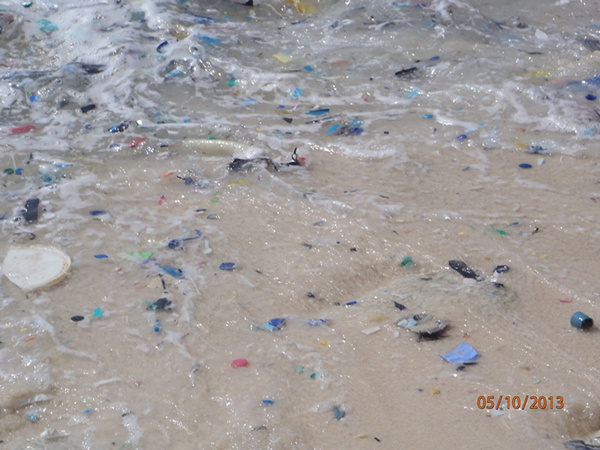Plastic in 99% of seabirds by 2050
 0 Comment(s)
0 Comment(s) Print
Print E-mail China.org.cn, September 1, 2015
E-mail China.org.cn, September 1, 2015
 |
|
Plastic fragments washing in the surf on Christmas Island, in the northeastern Indian Ocean. [Photo/CSIRO] |
Australian researchers predict that plastic ingestion will affect 99 percent of the world's seabird species by 2050.
Researchers from Commonwealth Scientific and Industrial Research Organization (CSIRO) and Imperial College London have assessed how widespread the threat of plastic is for the world's seabirds, including albatrosses, shearwaters and penguins, and found the majority of seabird species have plastic in their gut.
The study, led by Dr Chris Wilcox with co-authors Dr Denise Hardesty and Dr Erik van Sebille and published today in the journal PNAS, found that nearly 60 percent of all seabird species have plastic in their gut.
Based on analysis of published studies since the early 1960s, the researchers found that plastic is increasingly common in seabird's stomachs.
In 1960, plastic was found in the stomach of less than 5 percent of individual seabirds, rising to 80 percent by 2010.
The researchers predict that plastic ingestion will affect 99 percent of the world's seabird species by 2050, based on current trends.
The scientists estimate that 90 percent of all seabirds alive today have eaten plastic of some kind.
This includes bags, bottle caps, and plastic fibres from synthetic clothes, which have washed out into the ocean from urban rivers, sewers and waste deposits.
Birds mistake the brightly coloured items for food, or swallow them by accident, and this causes gut impaction, weight loss and sometimes even death.
"For the first time, we have a global prediction of how wide-reaching plastic impacts may be on marine species – and the results are striking," senior research scientist at CSIRO Oceans and Atmosphere Dr Wilcox said.
"We predict, using historical observations, that 90 percent of individual seabirds have eaten plastic. This is a huge amount and really points to the ubiquity of plastic pollution."
Dr Denise Hardesty from CSIRO Oceans and Atmosphere said seabirds were excellent indicators of ecosystem health.
"Finding such widespread estimates of plastic in seabirds is borne out by some of the fieldwork we've carried out where I've found nearly 200 pieces of plastic in a single seabird," Dr Hardesty said.
The researchers found plastics will have the greatest impact on wildlife where they gather in the Southern Ocean, in a band around the southern edges of Australia, South Africa and South America.






Go to Forum >>0 Comment(s)